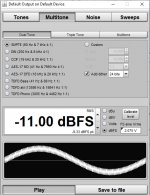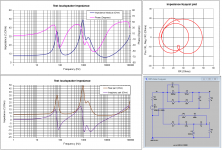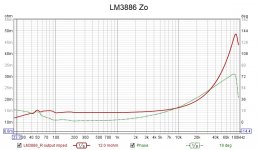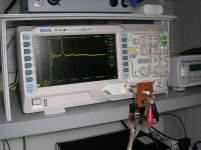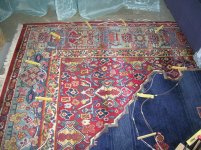That’s great George.
Looking forward to your measuring results but most of all to your listening experiences
Hans.
Looking forward to your measuring results but most of all to your listening experiences
Hans.
but most of all to your listening experiences
Hi Hans
If you mean the image centering test, I will do it (beware: shot ears !). In any case this test should to be repeated by as many people as possible
speaker cable myths and facts
John
at which end of the wiring do you suggest I should probe for IMD, amp end or load end (or both)?
Also what IMD test of those REW provides (plus custom suggestion) for this loudspeaker?
Amplifier will be an inverted LM3886 with low output impedance.
Pout (electrical) at 0.1W or 1W for the IMD test?
speaker cable myths and facts
George
Attachments
Load end. The "premise" is that the settling time of the cable will get between the amplifier's control node and the speaker. That decoupling should have less control over the load's non linearities.
As for the image centering tests, it does not require golden ears. Only the ability to localize frequencies we are sensitive to w/r to ITD shift vs frequencies which we are not.
jn
As for the image centering tests, it does not require golden ears. Only the ability to localize frequencies we are sensitive to w/r to ITD shift vs frequencies which we are not.
jn
This afternoon I run the image centering listening test.
L and R speakers connected to the same channel of an amplifier.
First run: Each 5m speaker cable bundle was four zip (2x0.5mm) cables parallel connected (all plus together, all minus together)
Second run: On the L speaker the four zip cables were split apart.
I had to toe in the speakers just in front of me for to narrow the center image in the middle. With a bit of practice I managed to bring my spatial sensitivity limit to +/- 5cm from center. After that I listened to the music for an hour on each run at two SPL levels. The low at 86dB max peak, the high at 92dB max peak
Unfortunately I couldn’t discern any difference btn the zip and the split cable bundles. Center image remained stable in the middle, same with zip and split cabling
Place the cursor over each attachment to read the description
P.S. Geppetto's animated figure is a creation of artist Gris Grimly (Steven Soenksen) for Guillermo del Toro's “Pinocchio”
George
L and R speakers connected to the same channel of an amplifier.
First run: Each 5m speaker cable bundle was four zip (2x0.5mm) cables parallel connected (all plus together, all minus together)
Second run: On the L speaker the four zip cables were split apart.
I had to toe in the speakers just in front of me for to narrow the center image in the middle. With a bit of practice I managed to bring my spatial sensitivity limit to +/- 5cm from center. After that I listened to the music for an hour on each run at two SPL levels. The low at 86dB max peak, the high at 92dB max peak
Unfortunately I couldn’t discern any difference btn the zip and the split cable bundles. Center image remained stable in the middle, same with zip and split cabling
Place the cursor over each attachment to read the description
P.S. Geppetto's animated figure is a creation of artist Gris Grimly (Steven Soenksen) for Guillermo del Toro's “Pinocchio”
George
Attachments
-
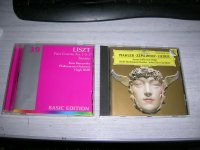 9 CDs used for the listening test.JPG634.2 KB · Views: 155
9 CDs used for the listening test.JPG634.2 KB · Views: 155 -
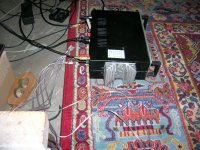 8 amplifier.JPG675.7 KB · Views: 152
8 amplifier.JPG675.7 KB · Views: 152 -
 7 amp side zip & split cables.JPG752.8 KB · Views: 155
7 amp side zip & split cables.JPG752.8 KB · Views: 155 -
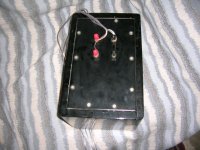 6 loudspeaker side zip cables.JPG650.3 KB · Views: 160
6 loudspeaker side zip cables.JPG650.3 KB · Views: 160 -
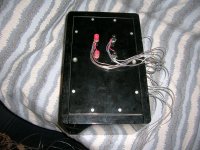 5 loudspeaker side split cables.JPG675.3 KB · Views: 156
5 loudspeaker side split cables.JPG675.3 KB · Views: 156 -
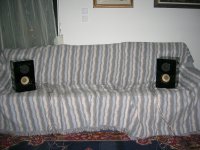 4 final toe in L split cables-R zip cables.JPG685.3 KB · Views: 139
4 final toe in L split cables-R zip cables.JPG685.3 KB · Views: 139 -
 3 final toe in both zip.JPG697.9 KB · Views: 154
3 final toe in both zip.JPG697.9 KB · Views: 154 -
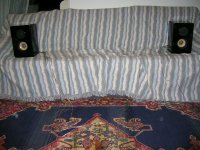 2 initial loudspeaker orientation.JPG698.6 KB · Views: 273
2 initial loudspeaker orientation.JPG698.6 KB · Views: 273 -
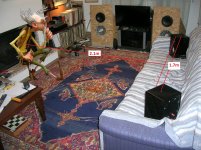 1 Listening test scene.jpg481.8 KB · Views: 286
1 Listening test scene.jpg481.8 KB · Views: 286
Hi George,
Thanks for sharing your results.
Looking at your hair blown behind your head in the first picture, SPL must have been at hurricane level 😀 😀
Nevertheless, no differences could be heard between the two configurations, so this test did not reveal what I was hoping for.
May be John has still something to add.
Hans
Thanks for sharing your results.
Looking at your hair blown behind your head in the first picture, SPL must have been at hurricane level 😀 😀
Nevertheless, no differences could be heard between the two configurations, so this test did not reveal what I was hoping for.
May be John has still something to add.
Hans
George,
What exactly did the zip cord look like that you used, diameter, number of individual wires and distance between the two conductors.
I will do a VNA test to get the characteristics when I have the exact cable details.
Hans
What exactly did the zip cord look like that you used, diameter, number of individual wires and distance between the two conductors.
I will do a VNA test to get the characteristics when I have the exact cable details.
Hans
You will not get proper imaging with speakers on a couch. Too much recoil.
For small box speakers I have used small but stout wooden tables with these things between the table top and speakers: Recoil - Primacoustic
Don't mind their theory write up, the things just work.
For small box speakers I have used small but stout wooden tables with these things between the table top and speakers: Recoil - Primacoustic
Don't mind their theory write up, the things just work.
Last edited:
"You will not get proper imaging with speakers on a couch. Too much recoil."
Can you explain why? No one who I've asked, who's said similar, seems to have come up with a proper explanation
Can you explain why? No one who I've asked, who's said similar, seems to have come up with a proper explanation
Think about it. A speaker is designed to for the diaphragm to move and the box to not move. Then sound is radiating from the diaphragm only, although the box shape helps to control dispersion.
OTOH, if the box recoils then the diaphragm is moving less distance relative to the rest of the room. The box is moving in the opposite direction from the diaphragm. Both are now sound sources, moving in opposite directions. That tends to cancel out some frequencies to some extent.
Also, the box as a moving source is not designed to launch a sound waves with proper dispersion. Some energy is absorbed by the couch in a non-designed for way. The whole thing is a mess.
OTOH, if the box recoils then the diaphragm is moving less distance relative to the rest of the room. The box is moving in the opposite direction from the diaphragm. Both are now sound sources, moving in opposite directions. That tends to cancel out some frequencies to some extent.
Also, the box as a moving source is not designed to launch a sound waves with proper dispersion. Some energy is absorbed by the couch in a non-designed for way. The whole thing is a mess.
Last edited:
Let's just stick to the recoil. There is an action and a reaction that causes a reduction in SPL, anything else?
That may be all that matters for mono.
For stereo the system would have to be designed so that the relative recoil between the two speakers is correct and time-invariant for all frequencies and phases to within the ITD parameter being tested for.
When it comes to speakers and rooms, one is dealing with a very complex situation. Some speakers work better than others, even then it depends where they are located and how they are mechanically stabilized.
For stereo the system would have to be designed so that the relative recoil between the two speakers is correct and time-invariant for all frequencies and phases to within the ITD parameter being tested for.
When it comes to speakers and rooms, one is dealing with a very complex situation. Some speakers work better than others, even then it depends where they are located and how they are mechanically stabilized.
Last edited:
Mark, any criticism on that test is justifiable.
Although I had to move furniture around to do it, I understand I have to try to push that couch out of the living room. This thing is large and weights more than 100kg. I have to be cautious too for my wife shouldn’t see the arrangements at least not before or during the test. Then I will use speaker stands.
Technical issues are easy to fix. It’s my ears that are the real problem. Everyone that is interested on the issue is kindly asked to do the test it and report.
Hans, please see first attachment.
Using home brewed TDR (fast pulse generator, an oscilloscope, a potentiometer for cable termination and an Ohmmeter), I checked for characteristic impedance of cabling
Each zip pair shows 155 Ohm.
The four paralleled zip pairs show 38 Ohm
The four split paralleled zip pairs show 100 Ohm.
Little to no variation in those measurements while moving the cabling around.
Next I will use the DE-5000 LCR meter and an impedance sweep with REW for data up to 100kHz.
George
Although I had to move furniture around to do it, I understand I have to try to push that couch out of the living room. This thing is large and weights more than 100kg. I have to be cautious too for my wife shouldn’t see the arrangements at least not before or during the test. Then I will use speaker stands.
Technical issues are easy to fix. It’s my ears that are the real problem. Everyone that is interested on the issue is kindly asked to do the test it and report.
Hans, please see first attachment.
Using home brewed TDR (fast pulse generator, an oscilloscope, a potentiometer for cable termination and an Ohmmeter), I checked for characteristic impedance of cabling
Each zip pair shows 155 Ohm.
The four paralleled zip pairs show 38 Ohm
The four split paralleled zip pairs show 100 Ohm.
Little to no variation in those measurements while moving the cabling around.
Next I will use the DE-5000 LCR meter and an impedance sweep with REW for data up to 100kHz.
George
Attachments
There is some good advice about learning how to listen by Paul Frindle in another thread somewhere that I linked to in a lounge thread with Paul's name in the title. This is from a technical person that had to learn how to do it.
My explanation: Its not your ears really, its your brain that may need some time learn to notice things that are plainly audible but not treated by parts of the brain as useful information to decode and forward on to conscious awareness. Part of learning hear those things is not to listen consciously for things you understand intellectually or theoretically. Rather it is to close one's eyes and allow yourself to imagine a live performance is taking place in your room. Give yourself permission to believe that is true, and allow yourself to sense the position in space, from left to right, and from close to far away, of each instrument and singer on the stage before you. Relax and experience the illusion; let the subconscious part of your brain figure out the signal processing for you.
EDIT: its perfectly fine and probably a good idea to turn your head as you wish while listening. That is a normal thing humans and animals tend to do when trying to locate a sound source by ear.
My explanation: Its not your ears really, its your brain that may need some time learn to notice things that are plainly audible but not treated by parts of the brain as useful information to decode and forward on to conscious awareness. Part of learning hear those things is not to listen consciously for things you understand intellectually or theoretically. Rather it is to close one's eyes and allow yourself to imagine a live performance is taking place in your room. Give yourself permission to believe that is true, and allow yourself to sense the position in space, from left to right, and from close to far away, of each instrument and singer on the stage before you. Relax and experience the illusion; let the subconscious part of your brain figure out the signal processing for you.
EDIT: its perfectly fine and probably a good idea to turn your head as you wish while listening. That is a normal thing humans and animals tend to do when trying to locate a sound source by ear.
Last edited:
Mark I understand that you are trying to help and I appreciate.
Unfortunately with the years I have developed a strong dislike for things that are regarded as essential for earning the ticket for the Hi-End train wagon. Experience for high resolution, acoustic space, depth, crisp imaging, ect. Give me to audition one of the Demonstration Disks, Chesky or whatever and I’ll jump out of the window. I listen to the music from a system long term only and most of the time without taking effort to do so.
Now this particular test is against my ways but only to see if phantom image moves from the center while music plays across the frequency spectrum. This and only this.
🙂
George
Unfortunately with the years I have developed a strong dislike for things that are regarded as essential for earning the ticket for the Hi-End train wagon. Experience for high resolution, acoustic space, depth, crisp imaging, ect. Give me to audition one of the Demonstration Disks, Chesky or whatever and I’ll jump out of the window. I listen to the music from a system long term only and most of the time without taking effort to do so.
Now this particular test is against my ways but only to see if phantom image moves from the center while music plays across the frequency spectrum. This and only this.
🙂
George
Got it. Then for this test I think you might be able to get away with only being about one meter from the speakers with the speakers one meter apart from each other, all together forming a triangle with speakers toed-in towards your ears. This is a standard near-field listening setup often used for mixing. Being close and working at low-ish SPL helps to reduce the influence of room effects.
Last edited:
Each zip pair shows 155 Ohm.
The four paralleled zip pairs show 38 Ohm
The four split paralleled zip pairs show 100 Ohm.
Little to no variation in those measurements while moving the cabling around.
Next I will use the DE-5000 LCR meter and an impedance sweep with REW for data up to 100kHz.
George
The four split paralleled is odd. Bundle the positives together, the negs together, and keep them at least 3-4 inches apart. You should be well over double the native zip.
The test is most sensitive when the speaker has a 20-30 ohm impedance in the 100ish hz range where we localize IID only, and a drop to 6-8 ohms in the midband where we localize ITD. If your speaker is flat through the entire range, there is nothing to see here...
And no need to apologize if you find nothing....it's just a test..
Thank you for the effort.
jn
- Home
- General Interest
- Everything Else
- Zip cord for speaker test
